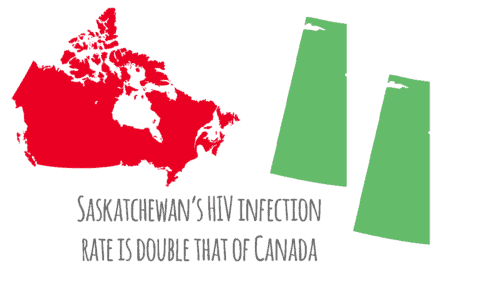In a province where the HIV infection rate is double that of the rest of the country, Saskatchewan is facing a public health crisis. Although there are lots of fears and misconceptions surrounding HIV and AIDS, with education and access to proper resources, University of Saskatchewan students can help combat the issue.
A group of Saskatchewan doctors recently called for the provincial government to declare a state of emergency in regards to HIV and AIDS. If you know the statistics, this news comes as no real surprise.
According to CBC News, Saskatchewan leads the Canadian provinces in new cases of HIV infection. Again, this means the HIV infection rate is approximately twice that of the national average. Saskatchewan saw HIV infections increase from 114 new cases in 2014 to 158 in 2015.
that of the national average. Saskatchewan saw HIV infections increase from 114 new cases in 2014 to 158 in 2015.
Additionally, the Saskatoon Health Region reports that since 2005, seven out of 10 HIV positive people were First Nations or Metis.
Saskatchewan is a province where a high percentage of the population is Indigenous — 15.6 per cent as of 2011 — the second highest in the country, according to Statistics Canada.
Combine these statistics with the fact that the HIV infection rates on some Saskatchewan reservations is comparable to the infection rate in sub-Saharan African countries like Nigeria and Rwanda, and it’s clear why doctors are calling this a state of emergency.
HIV and AIDS are not just “third-world” diseases, things that are completely removed from our existence in a prosperous western nation. They’re things that directly affect our province, our communities and maybe even ourselves.
As young people living, working and attending school in Saskatchewan, we can’t afford to ignore the facts. But with so much stigma still surrounding sexually transmitted infections, what steps can students take to protect themselves and prevent the spread of HIV?
For Natalya Mason, the sexual health educator at the Sexual Health Centre Saskatoon — a community based clinic that specializes in sexual health — combatting the spread of HIV comes down to three things: education, protection and testing.
“I think there are a lot of misconceptions about how HIV is transmitted,” Mason said. “For the record, HIV is only transmitted through five bodily fluids: blood, semen/pre-seminal fluid, vaginal fluid, rectal fluid and breast milk — not saliva and not toilet seats. I also get asked if people with HIV can have sex and the answer to that question is yes.”
Mason went on to add that when people who are HIV positive are undergoing antiretroviral therapy, it helps reduce the levels of the virus in the body, making it very unlikely for them to transmit the disease to sexual partners.
Speaking of sexual partners, Mason also emphasizes the importance of using proper protection to prevent the spread of STIs.
“If we’re talking about sexual contact, the best way to protect yourself against HIV and other sexually transmitted infections is by using condoms. They’re available for free on campus at Student Health and at the U of S Students’ Union’s Women’s, Pride and Help Centres. No excuses,” Mason said
Mason hopes that young people can make getting tested for STIs a normal part of their sexuality.
“Sex can be really great, but as a sexually active adult part of your responsibility to your partners — and yourself — is getting tested,” Mason said. “We’re all adults, there’s no reason to be embarrassed about being prepared for sex. By making that a normal part of our sexual encounters we can help reduce the stigma around testing.”
Even though the HIV epidemic can seem like something that’s far removed from our everyday lives, it really isn’t. It’s something that’s present in our communities and might even affect someone that we know and love.
Through proper education, preparation and health care we can all help to make Saskatchewan a healthier place to be.
—
Emily Klatt
Graphic: Lesia Karalash / Graphics Editor